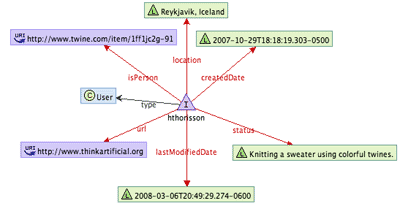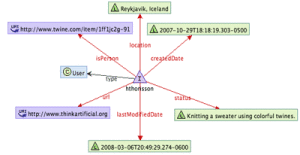These are my notes from the User-generated content session at Museums and the Web, Montreal, 2008. All mistakes are mine, any corrections are welcome, my comments are in [square brackets] below.
The papers presented were The Art of Storytelling: Enriching Art Museum Exhibits and Education through visitor narratives by Matthew Fisher, Alexandra Sastre, Beth Twiss-Garrity; The Living Museum: Supporting the Creation of Quality User-Generated Content by Allison Farber, Paul Radensky and Getting 'In Your Face': Strategies for Encouraging Creativity, Engagement and Investment When the Museum is Offline by Martin Lajoie, Gillian McIntyre, Ian Rubenzahl, Colin Wiginton.
The "Art of Storytelling" project at the Delaware Art Museum.
The paper covered visitor-contributed content (VCC), the key factors to success, and the motivations behind allowing visitors to contribute. The paper goes into more of the theoretical foundations.
The key findings of the Art of Storytelling project evaluation:
What's the value to the visitor who contributes? It engages visitors in thinking critically and creatively about and in response to art.
What's the value to the museum? They get feedback and to engage new audiences
What's the value to the other visitors? There is some confusion, but also it can be inspiring, enriching, and encourage others to participate.
It's not appropriate or appealing for all collections, but it's hard to predict which in advance.
[When looking at models of participation:] Allow the motivated to contribute, allow the rest to benefit; don't penalise for non-participation.
Simplicity – remove barriers to entry (engage first, login last if at all).
Promote in traditional and non traditional venues; have a clear invitation to participate.
Motivating factors included curatorial encouragement (have curators there encouraging people), juried selections, stipends for selected storytellers.
What's in it for the audience? They get 15 minutes next to an Andy Warhol. Establish an audience for your visitor-contributors – affiliation with an institution is valued, even if comes with caveats. [Theirs is an art museum – does that work for all audiences, or for all types of content?]
Don't try and create communities beyond the your collections (because others with bigger budgets are after the same eyeballs).
They gave lots of examples from a summary of evaluation of other projects (but the slides were hard to see):
Isabella Stewart Gardner Museum in Boston – thinking through art. Active looking skills.
The Wolfsonian Institute in Miami – Artful Citizenship Project.
Guggenheim – Learning Through Art.
Aldrich Contemporary Art Museum – Round by Halsey Burgund.
Denver Art museum – Frederic Remington exhibit, Hamilton building programming.
Philadelphia area art museums; art, literacy, museums.
They then provided some background information about the Art of Storytelling at the Delaware Art Museum – story telling kiosks in the museum.
Their 'a-ha' moment was realising that the experience was more transformational for the original story tellers (i.e. the adults) than the audience. Transcend traditional ideas re lack of authority.
In conclusion, visitor-contributed content programs are valuable to the original contributors and museums get valuable insight into audiences, but it's an open question as to whether they're valuable for other visitors.
The Museum of Jewish Heritage, supporting the creation of quality user-generated content in the "Living Museum".
The project started as outreach project for Jewish communities without local museum.
The process: students visit a local museum, learn a bit about how museums are structured in terms of display of objects and organisation. The students choose an artefact to represent Jewish heritage at home, then write labels at school. They then organise artefacts into galleries, create gallery title and text panels, then create in-school and online exhibitions. Students research artefacts and tell their own stories. They include measurements because you can't get a sense of scale on the internet. One piece of text tells story of artefact and the other tells significance of artefact to family.
[They aren't promoting it until they feel the site is ready – a familiar story!]
They run seminars with teachers to help them submit quality content, but they still get objects unrelated to Jewish heritage, text with spelling and grammar errors, incomplete labels, unclear photos, factual errors.
The goals included: educational – a connection to Jewish heritage, parental involvements, museology, improve writing and research skills; institutional – high quality images so people can see what they're looking at; privacy of students; motivation of students.
Teachers say students are motivated to get stuff right because it's going online.
Unlike other user-generated content sites, the content is pre-reviewed, as the project has very specific educational goals. They control who creates content on the website (anyone can use but only teachers from Jewish schools can post content) and check that kids can't be identified. They are trying not to expose the kids and their personal stories to comment or modification by other users.
They are going to implement a spell checker.
How can they help users to contribute quality content? Convey expectations, consider needs of both kinds of users, offer support, concentrate on process and product of exhibition creation, review submitted content and offer recommendations.
"In Your Face", Art Gallery of Ontario
In Your Face: The People's Portrait Project.
While the Art Gallery of Ontario building was under construction, they were interested in rethinking the way the organisation worked, and how to keep people connected to the institution.
They got the idea from UK's National Portrait Gallery BP prize, but they didn't want a contest.
They advertised on back of the national paper for a few weeks as they had free space. They wrote a copyright statement that people had to sign, specified a size, and said they would hang every piece that came in. They received 17,000 portraits.
First they got lots of entries from rural areas, then the rest of Canada and the world. There was an extraordinary variety in portraits, and also in the parcels. They also arrived with stories.
It was a one way thing – people knew they weren't going to get the portraits back. It mattered to them to get them exhibited in the AGO.
There was more diversity in portraits and in the people who came to see them than usually seen in the gallery. People paid money to see the portraits as they were 'after the gate'. It was lots of work for staff on top of their normal job cos it turned out to be huge, but gave them (the staff) energy. It also made their audiences real for the staff and helped make the institution inclusive.
Contemporary artists from their collection also sent in portraits, but their names weren't shown so it was all egalitarian.
They also created a Flickr group (but weren't able to get that projected in the gallery). It now has 10,000 portraits in it.
They had a parallel project – Collection X. It was an online project where visitors could make their own exhibition. Collect, connect and create. 'Open source museum' [- the online paper goes into more detail, including the use of RSS.]
Partly [?] as a result of the project, guiding principles developed for institution include relevance, responsiveness, creativity, transparency, diversity and forum.
Questions asked:
How do you balance museum's agenda with visitor expectations? Is it possible to assert control and foster programming that is open-ended? How do we think about expertise, quality and standards? How do we integrate and manage creativity in ways that are dynamic and long-term? Is curatorial expertise or audience experience paramount? Some things curators are uneasy about. Dynamism also means some volatility – how does that work?
Lessons learned:
Take risks, experiment and be willing to make mistakes
Museums can function as catalysts for creativity [my emphasis, this was the meme that ran through the whole session, for me]
A critical mass of creativity asserts its own kind of aesthetic
There is value in integrating user-generated content that is actual as well as virtual
Museum and the public can function as producers and consumers of culture to create a shared sense of ownership
The public will be invested if programming is authentic and they feel respected.

